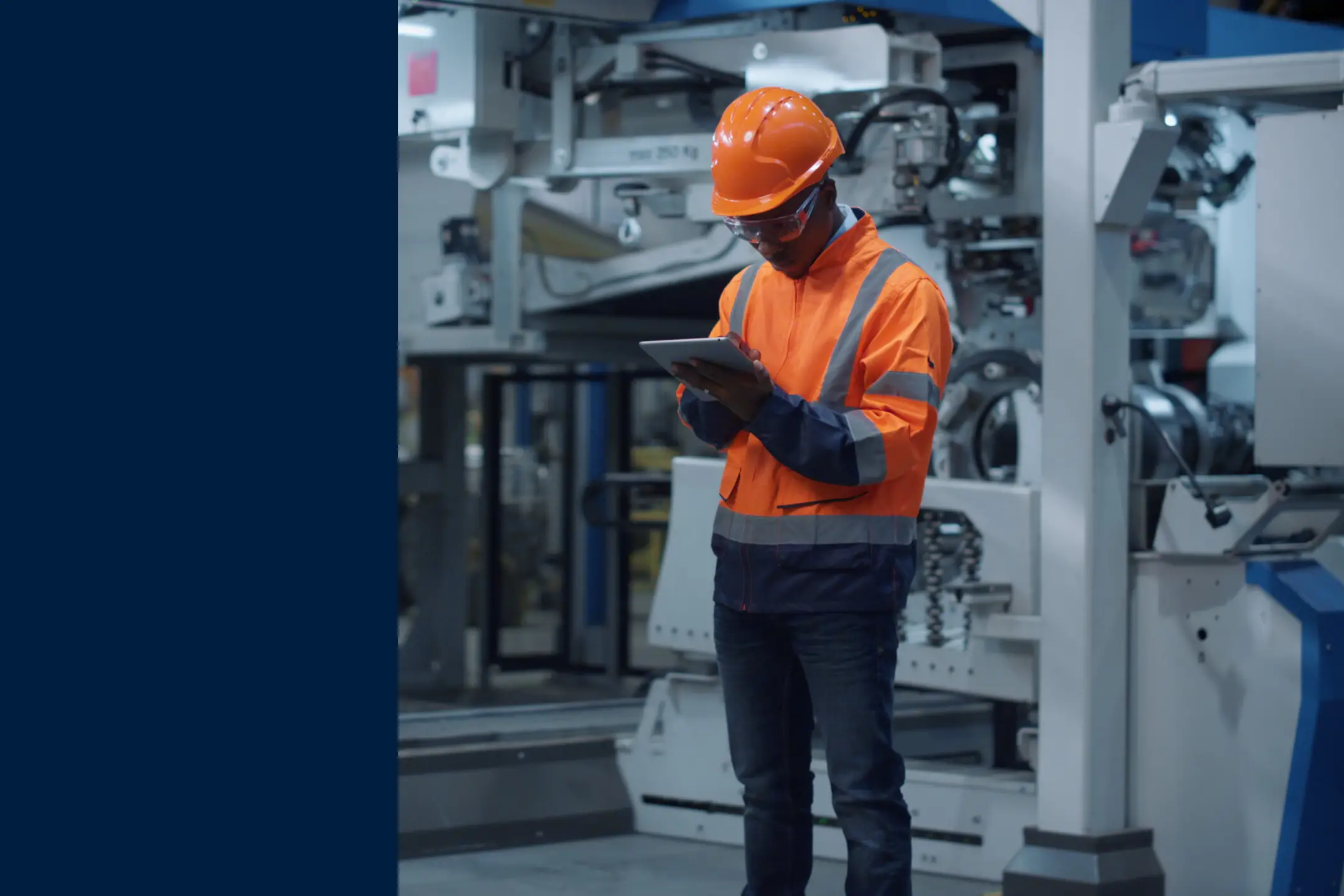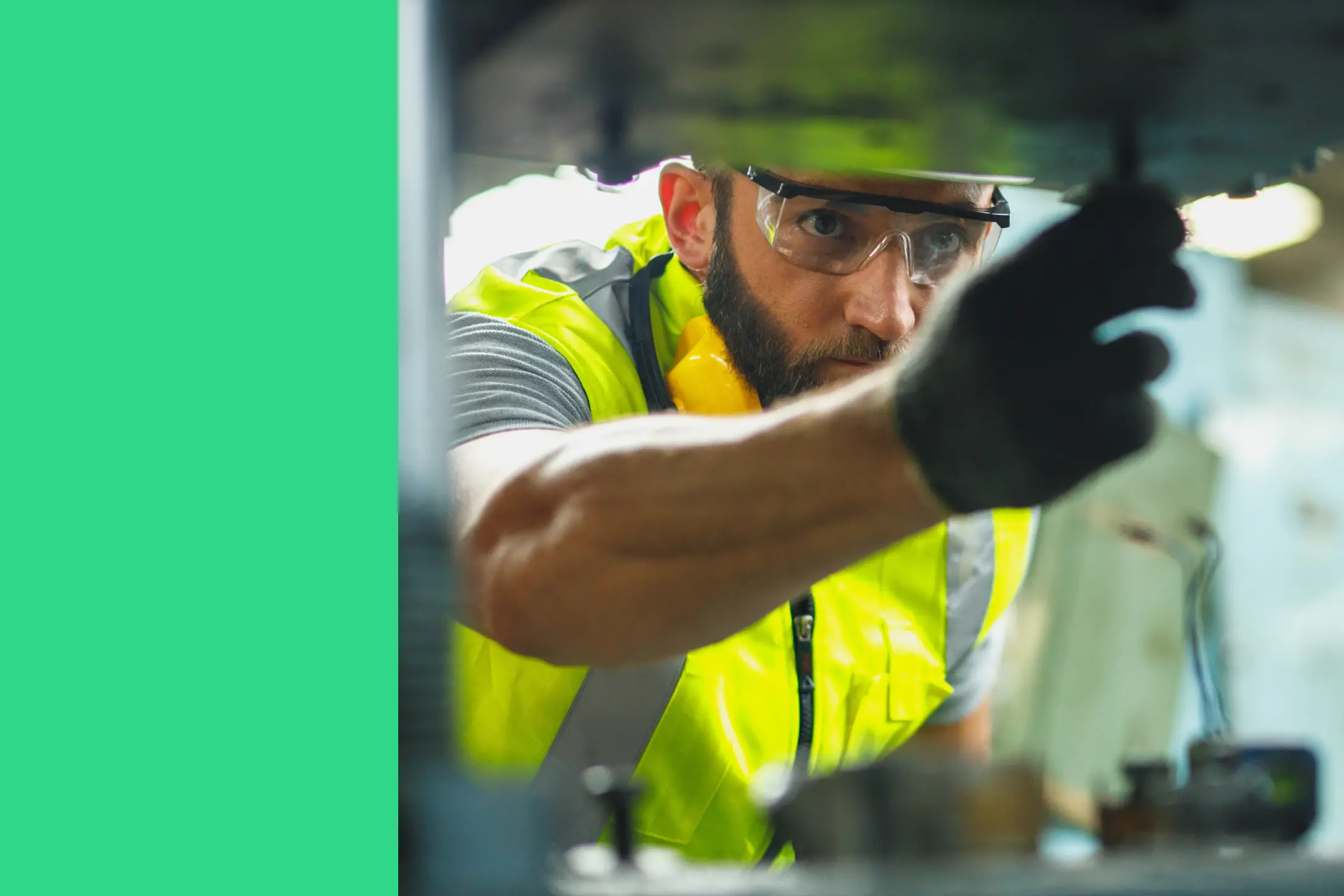
There’s no getting around it: companies often see maintenance as a cost. But, when done strategically, maintenance is actually a lever organizations can use to protect margins and boost growth. By optimizing your maintenance program to reduce cost-draining factors like unplanned downtime, you free up dollars for new lines, automation, or expansion projects.
One of the highest-impact steps you can take to turn your maintenance program into a growth engine is to prioritize preventive maintenance (PM) strategies. The numbers tell this story:
- Organizations that relied more on preventive and predictive maintenance had 52.7% less unplanned downtime compared to their reactive-heavy peers.
- Manufacturers are facing an average downtime cost of $125,000 per hour.
- Adopting predictive/preventive maintenance can increase equipment life by 20 to 40% and achieve savings of 30 to 40%.
Read on for the steps we recommend taking to build a successful preventive maintenance program in 2025.
Key takeaways
- Preventive maintenance helps teams move away from reactive firefighting. This ultimately leads to less downtime, lower maintenance costs, and improved safety.
- Tools like a Computerized Maintenance Management System (CMMS) can make your maintenance program less reactive by tracking and making it easier for your team to complete PM tasks.
- Continuous optimization is the key to long-term reliability.
What is preventive maintenance?
Under a reactive (or “run-to-failure”) maintenance program, teams fix assets only after they break. Preventive maintenance (sometimes called preventative maintenance) means teams perform scheduled maintenance on assets to avoid unexpected issues and failures. Some common PM tasks include inspections, cleanings, lubrication, and parts replacement.
At its core, preventive maintenance is about moving from reactive firefighting to proactive reliability. While reactive maintenance may seem cheaper in the short term since you only spend money when something breaks, it’s more expensive over time because breakdowns lead to damage, production downtime, safety incidents, and costly emergency repairs.
As our customer, an operations manager at Redimix, put it: “It's not about cost cutting. It's about training your team and maintaining your equipment so that you don't incur the costly downtime.”
Why preventive maintenance matters
Whether you’re running a manufacturing plant, a hotel, or a fleet of vehicles, a well-structured PM program keeps assets working safely and efficiently while protecting your bottom line.
These are some of the main benefits:
- Extended asset lifespan: Regular upkeep reduces wear and tear.
- Minimal downtime: Catching issues early prevents surprise breakdowns.
- Lower costs: Planned maintenance avoids emergency repairs and rush parts orders.
- Improved safety: Well-maintained equipment lowers the risk of accidents and compliance violations.
- Higher efficiency: Properly tuned assets consume less energy and run more reliably.
- Happier technicians: A safer, more proactive environment reduces stress and improves morale.
Types of preventive maintenance
The right way to approach preventive maintenance will of course depend on the types of assets you’re managing, your resource limitations, and your goals.
Here are different types of preventive maintenance to consider as you look to mature your maintenance program.
Definitions vary, so keep in mind that many treat the first two types here (time-based and usage-based maintenance) as “pure preventive maintenance,” while condition-based, predictive, and prescriptive are strategies that fall under the planned‑maintenance umbrella.
1. Time-Based Maintenance (TBM)
With time-based maintenance, also known as periodic maintenance, tasks are assigned on a fixed schedule (e.g., daily, monthly, quarterly, annually).
- Example: Inspect HVAC filters every 3 months.
2. Usage-Based Maintenance (UBM)
Usage-based maintenance relies on tracking equipment usage data to determine when maintenance should be performed. An asset’s usage will trigger maintenance, rather than just a calendar date (e.g., hours run, cycles, mileage).
- Example: Service forklifts every 200 operating hours.
3. Condition-Based Maintenance (CBM)
Condition-based maintenance uses monitoring systems to detect early signs of wear or failure. Sensors or manual inspections detect early signs of wear, which prompts maintenance.
- Example: Replace a motor bearing when vibration levels spike.
4. Predictive Maintenance (PdM)
Predictive maintenance programs use advanced analytics and sensor data to anticipate equipment failures and optimize maintenance schedules, building on the foundation of preventive maintenance.
- Example: Thermal imaging detects overheating electrical panels.
- Learn more: Predictive vs preventive maintenance
5. Prescriptive Maintenance
Prescriptive maintenance goes beyond PdM, using AI to predict failures AND recommend the best corrective action.
- Example: The system performs an analysis and recommends adjusting conveyor speed and replacing seals to prevent breakdown.
Even the most “mature” maintenance teams use a mix of these strategies (with time-, usage- and condition-based preventive maintenance as their program’s backbone) since many assets aren’t critical enough to justify the cost of advanced PdM monitoring.
The key is finding a balance that helps you avoid downtime while protecting your resources.
Preventive maintenance examples by industry
Most industries consistently see higher reliability and lower costs when teams apply preventive maintenance effectively. Here are a few examples and benefits for different types of teams.
How to Build a Preventive Maintenance Program
A comprehensive preventive maintenance plan that includes a structured preventive maintenance process will help your team gain efficiency and improve long-term equipment reliability. Here’s how to set the stage for a smart PM strategy and help your team stay consistent with the program.
Step 1: Create an asset inventory
Before jumping into scheduling tasks and creating checklists, you need to compile an asset inventory.
A complete asset inventory is the foundation of a successful preventive maintenance program. And the most effective inventories go beyond a simple list of asset names. Here are some key details you’ll want to capture for each asset:
- Asset name and type
- Location within the facility
- Manufacturer and model number
- Installation or purchase date
- Warranty status
- Maintenance history
- Current condition or inspection status
- Attachments (manuals, specs, diagrams)
While you can capture this data in a spreadsheet, an asset management platform like MaintainX makes it easier to update, search, and track equipment over time.
Step 2: Prioritize critical assets
Not every piece of equipment is valuable enough to justify spending the time and budget on preventive maintenance. So how do you decide which ones are? Knowing which assets take priority isn’t always clear-cut.
This is where an asset criticality assessment can help. During this exercise, you’ll rank each piece of equipment by how often it fails and how it impacts factors like: safety, compliance, production impact, and downtime.
You can use a numeric scale (e.g. from 1-5, with 1 representing the lowest risk and 5 representing the highest) to give your team a repeatable way to evaluate each asset. See an example of this below:
Once you’ve identified the most important assets, you can start planning to implement preventive maintenance where it matters most.
Step 3: Choose maintenance triggers based on historical data and OEM guidelines
After choosing the right assets to monitor, you’ll need to figure out what to measure (using time-, usage-, or condition-based monitoring strategies), and what numeric thresholds will accurately trigger maintenance.
The goal is to set the right thresholds so your team completes maintenance only when needed: not too early, not too late.
If you’re monitoring an asset based on usage, for example, the metric you choose should correspond with how the asset wears or fails. Here's a breakdown of some common usage-based metric types. Start with what’s easiest to measure and most relevant to the failure pattern.
If you have limited data, you can use industry benchmarks or manufacturer guidelines to determine your preventive triggers and schedules. These are typically based on design specifications and testing, and serve as a reliable starting point.
Some good sources of guidance include:
- OEM manuals and spec sheets (e.g., for a hydraulic press, the OEM may recommend monthly lubrication, quarterly inspections, and annual seal replacements)
- Industry benchmarks: If you're unsure of benchmarks, reach out to your industry network or review published preventive maintenance intervals from trusted maintenance associations.
While OEM manuals are a good place to start when figuring out your first PMs, asset health reports can highlight which components need more inspection, or reveal that the OEM manual is calling for more maintenance than is actually necessary. So if your team has tracked work orders or failure data in a system like a CMMS or EAM, that information can help you find patterns that can improve your scheduling accuracy.
Step 4: Build a Preventive Maintenance Schedule
When it’s time to define your PM tasks and assign responsibilities, aligning with operations is a good starting point. After all, the most effective PMs aren’t scheduled in a vacuum. You’ll want to think about how maintenance windows line up low-demand periods and planned downtime, and adjust schedules for seasonal production spikes or slowdowns.
Define task lists
A good PM schedule not only tells your team when work should be done, but what should be done. Each preventive maintenance task should be clearly documented to encourage consistent, safe, and high-quality work across your maintenance team.
For each task, we recommend outlining the following:
- Task name
- Frequency
- Detailed steps for performing the work
- Tools required
- Parts required
- Estimated time to complete
- Required safety procedures or lockout/tagout steps
Standardize with procedures and preventive maintenance checklists
Consistency for your procedures is critical, especially in multi-site operations, since discrepancies in how PMs are performed can lead to unpredictable asset behavior and failures.
It helps to develop SOPs (Standard Operating Procedures) or digital preventive maintenance checklists for each recurring task, and use template-based PMs for similar asset types. One technician skipping a torque check could compromise the whole line, but SOPs make sure no details are missed.
Get the right communication tools
Sticking to a PM schedule gets tricky without the ability to easily collaborate on repairs. This is where mobile-first CMMS/EAM tools come in; these tools make it easy to ask questions and access information anywhere, any time.
Step 5: Digitize your program with a CMMS
While it's possible to start a preventive maintenance program using spreadsheets or paper-based systems, manual methods mean relying on someone to check a calendar and remember to assign or complete the task.
When you digitize your system, all the data and schedules are in one place, and you can notify the right people automatically. This helps increase PM completion rates. In fact, companies like Cardinal Glass report completing 70% more preventive maintenance work orders year-over-year after implementing MaintainX.
You can use a CMMS or EAM to:
- Schedule recurring PMs and generate alerts when a task is due or overdue
- Assign and track work orders with due dates and priority levels
- Attach SOPs, manuals, photos, and checklists to each task
- Standardize processes across teams and locations (with tools like MaintainX CoPilot, you can turn OEM-provided manuals into standardized work orders and procedures with just a few clicks)
- Track completion rates, parts used, labor hours, and downtime
- Preserve institutional knowledge that would otherwise stay in technicians’ heads and disappear with turnover
Overall, to create an efficient preventive maintenance program, you need systems that make it easy to be efficient.
Step 6: Measure, optimize, and gain support for continued success
Tracking the right KPIs can help you continuously refine your program to reduce downtime and costs. Choose a few to focus on based on your main goals.
Here are some good options to consider. You can also take a look at our guide for a deeper look at how to choose the right KPIs.
- PM Compliance (%): PM work completed on time
- Schedule Compliance (%): Scheduled work finished within the window
- Planned Maintenance Percentage (PMP %): Planned hours ÷ total hours
- Reactive Work (%): Unplanned work share (aim low and trending down)
- Repeat Failures (#/month): Same asset/same code within 90 days
Stick to a tight set of KPIs defined the same way every month, and use standardized, published definitions where available to make sure you’re doing apples‑to‑apples benchmarking across sites.
Making sure your metrics matter to the business
Connecting these maintenance metrics to business impact can drive changes at the highest levels of your organization. Making this connection is critical, because moving away from reactive firefighting requires a cultural shift that extends beyond the maintenance team.
If maintenance is only ever called when something breaks, you need to work toward changing leaderships’ mindset. With their support, you’ll be able to update processes and get the right technology to implement a solid preventive maintenance program.
Avoiding common preventive maintenance mistakes
When it comes to implementing a preventive maintenance program, teams tend to run into a few common pitfalls.
- Over-maintenance means your team is repairing assets more often than necessary, leading to wasted time and resources. This is why it’s important to regularly look back at technician notes and failure data to reevaluate your PM schedules. Also, if you find it harder to predict failures and time PM service correctly for certain assets, those assets may be good candidates for condition-based maintenance methods.
- Inconsistent processes across sites weaken the cost-efficiency and compliance benefits of a preventive maintenance program. Standardizing maintenance processes and PM procedures in a mobile CMMS and tracking KPIs like schedule compliance and MTBF can help with this issue.
- Poor documentation creates compliance risks and makes it harder to improve maintenance schedules and troubleshoot repeat issues. Train staff to consistently log maintenance activities so accurate data is always available. Don’t underestimate the value of real-time data access for this purpose. Your data is only valuable if it’s easy to add and use, and a mobile system makes that possible.
- Not involving maintenance technicians when you’re designing and refining a preventive maintenance program can lead to low buy-in, unrealistic schedules, and less effective maintenance, since the people closest to the equipment aren’t contributing their hands-on expertise. Involve maintenance technicians early and often through pilot runs and frequent feedback sessions..
Looking ahead
Keep in mind a successful preventive maintenance program isn’t a set-it-and-forget-it project. You’ll need to reassess your assets and schedules on a regular basis, or as soon as you start seeing new failure trends or updates to production priorities. This way, your program will evolve with your team and company goals.
By implementing preventive maintenance, you’re positioning your company for long-term profitability and setting the stage for advanced strategies (like predictive maintenance) that can take your facility to the next level.
Check out more stories of how our customers across industries have achieved ambitious goals by improving their preventive maintenance programs, or book a demo to see how we can help you achieve yours.
Preventive Maintenance FAQs
How often should preventive maintenance be done?
Perform preventive maintenance depending on your equipment usage, environment, and manufacturer guidelines. High-usage or critical systems may require monthly checks, while low-usage items might be maintained biannually. Always follow OEM schedules to prevent failures and extend asset lifespan.
Is preventive maintenance cost-effective?
Preventive maintenance is cost-effective because it reduces emergency repairs, extends equipment lifespan, and lowers downtime. Studies show that every $1 spent on preventive maintenance saves $4-5 in future repair costs. It also improves safety and operational efficiency, making it a financially sound strategy for asset management.
What’s the difference between preventive and preventative maintenance?
The main difference between preventive and preventative maintenance is language preference. Both terms mean the same thing: scheduled maintenance to prevent equipment failure.
Which industries benefit most from PM
Industries that benefit most from preventive maintenance include manufacturing, transportation, healthcare, energy, and facilities management. These sectors rely heavily on equipment uptime, and PM helps avoid costly failures, improve safety, and extend asset life. Regular maintenance ensures continuous operations and reduces unplanned downtime.
Can AI improve preventive maintenance?
AI improves preventive maintenance by predicting equipment failures, optimizing maintenance schedules, and analyzing real-time sensor data. Machine learning models detect patterns that indicate wear or risk, allowing early intervention. This reduces downtime, cuts costs, and increases asset reliability across industries using predictive insights.









.webp)